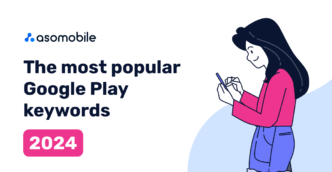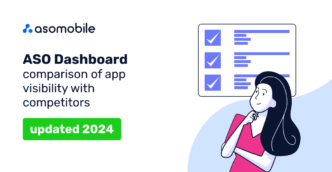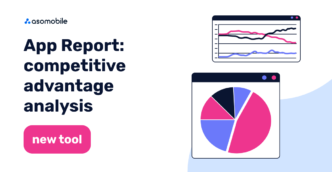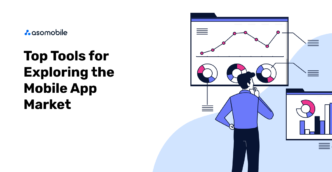The Complete Guide to ASO
On our blog, you can easily find more than a variety of instructions and approaches to app store optimization, but we decided that finding a complete guide to ASO with trends is much more convenient.
Looking to the future, we can definitely say that the mobile application market does not show susceptibility to crisis phenomena; new applications are being born, and competition is becoming increasingly lively. But who is definitely susceptible to minor moods is our users - they have become more demanding and economical. That is why it is worth starting with ASO optimization as the basis for the organic growth of our applications.
What is App Store Optimization?
ASO: what it is, how it works, and what it serves.
As we can observe, the number of new applications has been showing negative dynamics since 2021. Still, this indicator tells us more about the saturation of the application market than about any crisis. Users were so willing to install game applications during the pandemic (and there was nothing special to do) that in subsequent years they preferred offline activity - this is on the one hand. On the other hand, the integration of applications into everyday life is higher than ever; we track every sneeze, and news arrives in notifications from the corresponding apps, and spending a free couple of hours putting three in a row is sacred for every mobile user.
If all this doesn't seem so convincing, then look at the data from Statista:
- According to a user survey, more than 75% of emails and correspondence for communication were carried out on mobile devices. By comparison, entertainment, such as listening to music and watching videos on smartphones, was popular with about 60 percent of survey participants.
- User engagement is gradually decreasing, but it seems that this indicator has reached a plateau - after the peak of engagement during COVID-19, to the realities of post-pandemic life, when combining both online and offline activities is possible.
- As for the installation rate, according to the forecast of the same Statista, it is expected that until 2027, the download rate will grow significantly in all categories of the mobile market. There is a constant increase in installations across all segments. Notably, the Games category will reach its highest-ever figure of 176.1 billion downloads in 2027.
What does this mean in the context of app optimization? But only that it was and remains the base, the foundation for further advancement and success. Organic installs are becoming increasingly valuable as advertising budgets will soon break records in the fight for users, but financial restrictions will clearly conflict with market realities.
ASO is a source of organic app growth
To achieve installation of our application among more than 5.4 million applications is the number one goal and task. Approaches to achieving it can be organic and inorganic user attraction. Combining these two approaches is the basis of successful marketing, but one cannot exist without the other. If, with the help of paid campaigns, we achieve installation of the application, but the budget runs out, the installations will also end. In the case of ASO, the result may not be so stunning, but more reliable. Indexing the application will allow us to appear in search results, and visual elements will convince the user that we are exactly what he is looking for. In this way, we obtain a completely organic and long-term resource for installations.
ASO vs. SEO
How correct is the statement that ASO optimization is actually SEO for applications?
Let's figure it out - this is the first goal pursued by SEO and ASO. They are similar: to show your product to the maximum number of users. The difference is that SEO is aimed at improving the visibility of the website and at the highest possible positions in the search results of systems such as Google, Yandex. ASO optimization increases the visibility of your application in stores such as Apple Store, Google Play, Huawei AppGallery, etc.
What exactly is optimized?
SEO optimization involves working with site structure, user interface and web page loading speed. The elements for optimization are the meta-titles and the text part. Optimization satisfies the requirements for page content, its quality and user engagement. Also, a well-designed internal linking of pages, the presence of external links from other sites and transitions on them are mandatory.
ASO is a process that involves collecting and analyzing search queries, keywords and their use in application metadata via ASO optimization tools. Optimization for Google Play and the App Store are processes with similar goals, but different approaches due to the difference in the mechanisms for indexing metadata fields. ASO optimization implies not only working with the text part of the application, but also visual elements, because they are responsible for the conversion to install.
How does App Store Optimization work?

Optimizing mobile games and applications solves several problems at once:
- App indexing - when an app is displayed based on the keywords used in the metadata. Next, the ball is in the user's court.
- Search for an app. After entering a search query in the app store, the user will see the search results. It is thanks to text optimization that correlation occurs - a search query and an application display.
- Being user friendly. The application appeared in the search results of the user, now it is necessary that its "appearance" causes the necessary associations. The icon and screenshots of the application should be clear and attractive - the conversion to install occurs precisely thanks to the visual elements.
How can a user find an application?
People mainly search for specific apps on app stores like Google Play Store and Apple App Store. Just statistics - 70% of mobile users use search to find new apps. Moreover, 65% of all downloads occur immediately after a search. The obvious conclusion from this is that app store search is the most common method for discovering new apps.
Do not forget that the rating of the application and the number of downloads are factors that directly affect the search results, therefore, investing time and money in ASO, you lay the foundation for its subsequent growth.
Briefly about the benefits of ASO optimization:
- guaranteed visibility of your app in search results;
- the application is shown only to interested and targeted users;
- constant growth of organic installs because ASO optimization is about organic;
- reducing the cost of app growth in the long term by reducing advertising costs and the flow of organic users;
- app globalization by using additional locales.
Keyword research and prioritization
Keywords, search phrases and queries are the basis of an app optimization. Search, collection and analysis of the semantic core is the goal that is pursued to obtain indexing, place in search results and even install an application. Based on this concept, it becomes obvious that the first steps of our text optimization can lead us either to nowhere or to the realization of the goal.
If in the previous paragraph we dealt with the possibility of organic installations by keywords, then here it is worth mentioning the most important characteristics of the search queries with which we will work, namely:
- relevance. The quality of the search query, which is responsible for the correspondence of the keyword to the functionality of the applications.
- traffic. This is a number that shows how many times per day users entered this keyword into the store's search bar.
- popularity. A characteristic that speaks for itself, but do not forget that it is popular not only among users, but also among competitors.
- Apple Search Ads. Let’s make a reservation right away that this characteristic will only apply to iOS games and applications. This is an indicator of the popularity of the request, but only in terms of advertising on the App Store. This serves as an excellent guide for promoting the application in the future, and can also be a source of semantics.
Other search queries based on these characteristics can be divided into the following groups:
According to ASO meaning:
- relevant
- irrelevant
By length:
- short-tail keywords (no more than two words)
- long-tail keywords (more than two words)
By traffic:
- high frequency
- mid-frequency
- low frequency
By brand affiliation:
- branded
- not branded
The list goes on, but those are the main things you need to focus on when working with keywords.
Having dealt with their groups, types and categories, a logical question now arises - where to get the keywords, and how to understand what properties and characteristics they have? We have come close to the sources of semantics of mobile games and applications.

Based on the functionality and competitive field, you can easily get the initial list of keys - we answer the question, what does our application and our competitors do? We receive a list of relevant search queries. Now we go to the store or market and use the hints - we check our relevant keys and see what messages appear in the search bar. In this way, it is already possible to form a draft view of the semantic core. But now let's move on to the most important thing. The keywords which we will work with must meet two criteria at the same time - phrases that are exactly what users are looking for and specifically about the functionality of our application. These two properties must exactly match. And if everything is clear with the functionality, then how can you find out how and what users are searching for? This is where ASO tools come into play.
Below we will explore this issue in great detail, but for now it is clear that it is the analytical platforms that will show us the most important characteristics of the keywords that interest us (traffic, popularity and relevance). In addition, analytics will allow you to study each competitor - by what words it is indexed, by what key queries it receives installs, in what geographies it is represented, what styles of design of visual elements dominate in a particular niche of the mobile market. Essentially, we can get the widest possible access to other people’s experience, draw conclusions and form our own vision of the product.
As a result, the generated semantics will be a list of keywords that are relevant and with traffic, for subsequent use in metadata. The semantic core is not a static pool of queries, since market trends, competitors and users themselves with their preferences can change the search pattern. What is trendy and popular today, and therefore should be reflected in our metadata, after a certain period loses its relevance and we again return to the roots - we search, analyze and use the necessary keywords for our app or game.
Analytical tools for ASO optimization
Thanks to mobile analytics platforms, working with the application's semantic core and metadata will be easy and, most importantly, efficient. Optimization tracking, competitive analysis, and market research will all create a solid foundation for your app development and promotion strategy.
ASOMobile is a mobile application analytics platform that will allow us to carry out a full range of optimization measures. From planning, competitor analysis, metadata development, to working with ratings and reviews, and of course, measuring the effectiveness of our efforts.
- Analysis of the competitive field is possible both in terms of keywords and planning downloads and revenue. A whole Competitors analytics section will help us:
- Compare competitors' keywords in one tool - Spy Competitors.
- Find out competitors' keywords and compare search positions with our application - Spy Keywords.
- Research competitors' keywords on Google Play and App Store in 60+ countries - Spy Explorer.
- Analyze applications that are advertised in Apple Search Ads for a specific request - Search Ads Spy.
- See what the visual design of a whole pool of competing applications looks like at once - Visual Comparison.
- Assess the level of downloads and income of competitors - Downloads and Revenue.
- Collection and analysis of the semantic core using the following tools:
- By what keywords our application or competitors' is indexed - App Keywords.
- Search for relevant keywords - Keyword Finder, Keyword Select, Keyword Suggest.
- Checking the found keywords - in the search results (in each tool), for presence in the suggestions using Suggest Checker.
- Creating and testing new search queries - Keyword Combinator.
- Storage, analysis, and tracking of indexation of our semantic core - Keyword Monitor.
- Metadata generation - ASO Creator, Keyword Builder and Text Analyzer.
- ASO optimization effectiveness analysis - ASO Dashboard, Worldwide Check, Keyword Report and Organic Downloads.
- Working with ratings and reviews - Rating & Reviews, templates for responding to reviews and integration with the developer console.
- Marketing research of the market and competitors. Featuring tracking. Top charts and categories.
All this only partially describes the capabilities and functionality of analytical tools, but gives us an effective and holistic approach to ASO of an app.
AI and ASO
Artificial intelligence has already burst into almost all areas of our lives, so we should not ignore its capabilities for optimizing applications. Even if we don’t mention the built-in AI tools in analytical platforms, even turning to the original source can help us with ASO optimization:
- Selection of keywords - we will describe to Chat GPT our functionality and get a list of relevant keywords as a result.
- Formation of metadata - it’s easy to come up with options for titles and subtitles using the search queries we need! This could be a solution to our creative endeavors or just give a nudge in the right direction.
- But it’s worth talking more seriously about visual elements - after all, the creation of icons and screenshots with the advent of AI will reach another level. Easier, more varied and simpler.
P.S. and now what will usually be written in small print in any promotional text. AI is a fresh influx of ideas, simplifying work and saving our energy, but not a replacement. After all, even in the selection of keywords, no artificial intelligence will tell us traffic indicators, Apple Search Ads, and we will have to check the proposed keys for relevance ourselves. As for the visual elements, it's all up to the users when we run A/B tests, although using AI we can significantly increase the number of experiments we do, which will help us find the perfect combination in terms of conversion.
ASO optimization for Google Play vs. App Store
On Google Play, you need to use search queries multiple times in the metadata for the market to know that they are relevant to your application.
- Name. Keywords from the title carry a lot of ranking weight. Add the most relevant and effective keywords.
- The short description affects rankings and conversions. Use relevant keywords. Add a call to action to boost conversions.
- Full description. The optimal description is about 2000-2500 characters. Use mid-frequency and low-frequency search queries in direct entering. Avoid keyword stuffing (keyword stuffing is the overuse of keywords).
Please note that on the App Store you do not need to duplicate keywords. If you have already used a search query, for example, in the title, you should not enter it in keywords. Try to use as many different queries as possible.
- Title. Keywords from the title carry a lot of ranking weight. Add the most relevant and effective keywords. Use as many characters as possible.
- Subtitle. Subtitles affect rankings and conversions. Use relevant keywords. Add a call to action to increase conversions.
- Keywords. Use a variety of keywords. Do not duplicate words from the title and subtitle. Write your search queries in separate words (for example, not "games for children", but "games,for,children"). Do not put spaces after commas.
- Localize your app. In the App Store, localization can help you not only adapt your app to the local market but also increase the number of characters for keywords.

In addition to what has already been mentioned, do not forget about the application release mechanisms - it is common for Google Play to change metadata without updating the application itself, which usually leads to a partial or significant drawdown of existing positions and keyword indexing.
The App Store boasts less noticeable fluctuations in indexing after a release or metadata update (both of which require downloading a new build of the application), there is also a “short-term memory” of the store for those keywords that were previously indexed, but if they are removed from the metadata, then they will soon disappear from indexing.
Visual ASO
Regardless of the app store, there is a specific sequence of processes for ASO app optimization. First, we will split the optimization into text and visual. The main stage of text optimization is working with key queries of the app. It is worth relying on common sense, logic and market research here.
Screenshots and an icon are the next important part of visual ASO optimization, as visuals are hugely important for increasing conversions:
- Icon. Bright and memorable, meaningful and connected with the content of your product. An icon is what your app is, what it is about, and how you want to interact with users.
- Screenshots. Bright and understandable, fully revealing the sense of the app and highlighting its main functions.
- Video - will help introduce users to the functionality and capabilities of the application in life mode. Or it will show part of the game process and give you the opportunity to try playing without installation, which certainly has a positive effect on user engagement.

Seasonal app updates
It’s logical to mention seasonal updates after visual elements, because they are the ones that experience the greatest changes due to holiday updates and special calendar dates.
The seasonality of ASO for games and apps is to adapt and update our app based on the theme of the event. What for? Additional contact with possible users, an anchor to attract attention, non-verbal communication that says that we:
- We share the interests and festive mood of our users.
- We want to congratulate them on an important event on the calendar.
- We update and constantly work with our application.
From a simple example, looking at the search results, at a number of more or less similar icons, user attention in the pre-New Year bustle will be more likely to be drawn to an application with a seasonal update (Christmas tree, snow, ornaments on the icon). And if we are talking about cultural features, then stylizing visual elements for the Chinese New Year will demonstrate to the eastern part of the user audience our loyalty and support for their cultural values.
But it's worth noting that keywords are also subject to seasonal fluctuations - a great example is the app in the Shopping category - updating metadata with keywords like Black Friday, Cyber Monday or Singles' Day can be a great push for organic installs on days when users are more than willing to buy.
Rating and reviews

User reviews are an integral factor in evaluating your store app. Both stores take into account the comments and reviews that the user leaves for your app. The higher your ranking, the more relevant your app is considered in stores, and this is reflected in the app position in search results.
Plus, 80% of mobile users read at least one review before downloading an app. Therefore, it is very important to respond to reviews, thereby maintaining feedback. After all, this is the very process of engagement and users from potential go to the category of users who downloaded and installed your application.
Lifehacks of ASO app optimization
We try to strictly follow the rules and optimization techniques for different stores, but do not create “template” processes. Therefore, in addition to basic text and visual optimization, it is necessary to use all the opportunities that app stores provide us, and which can strengthen our position in search results, help with indexing and attract the attention of users.
In-app Events are temporary events on the App Store that can be located on the app page, in search results, in individual recommendations and selections. From an ASO point of view, we have at our disposal:
- Event name: 30 characters.
- Short description: 50 characters.
- Full description: 120 characters.
You can run up to five events simultaneously. This will help with the expansion of semantics, keyword ranking and position in search results. Plus, it will help with user attention - an in-app event could be a great reason to use it again.
LiveOps on Google Play are events in applications that are dedicated to promotions and special offers, competitions and events, as well as update releases. LiveOps occur in tabs, listing, and app pages.
What about ASO?
1. The name LiveOps is a field hidden from users and not indexed. We can use 80 characters at our discretion.
2. Description - 80 characters. Opinions differ here, as some ASO specialists tend to claim that this field can be indexed by the store, so it would be a good idea to use keywords.
The full description (500 characters) will be displayed on the store. Although it’s not indexed, but attracts attention.
Custom Product Pages (CPP) on the App Store and Custom Store Listing on Google Play.
Special pages for different categories of users, that's what CPP from the App Store and CSL from Google Play essentially represent. And if the experimental look of the page leads to installation, we have achieved our goal. Using CPP and CSL we can:
- Create different pages of our application, taking into account the behavioral demographics and cultural characteristics of our users.
- Different pages for advertising campaigns, which increases their effectiveness.
- Demonstrate new features of our game or application to a target, interested audience.
- Localize the page for a specific language and region.
In addition to all of the above, we can find the ideal design for our app page, which has a positive effect on conversion and resonates with our users.
The last of the life hacks, since this field is only available on the App Store, and is not indexed by the store, but its location on the page speaks for itself - it is visible to all visitors and the allowed length is only 170 characters. All this suggests that Promotional Text can be a great opportunity to reach users and interest them. This field can be changed frequently; it does not require updating the app itself, so Promotional Text is our channel for notifying visitors to the application page.
ASO trends and forecasts
ASO will remain a critical strategy for mobile app developers, marketers, and ASO professionals. Brief takeaways to consider when developing and implementing App Store Optimization:
- Keyword optimization: it continues to be the cornerstone of ASO. It involves researching and using keywords that potential users may enter when searching for applications. Tools like ASOMobile provide robust keyword research tools, helping us identify high traffic keywords that are relevant to our app.
- Appname a nd description. The app name is catchy, unique and includes the main keywords - it's a good name. The description should be clear, concise and informative, describing the main features and benefits of our application. It should also include relevant keywords (for Google Play), but avoid overspam.
- Visual elements. The app icon, screenshots, and video previews are key in attracting users. They should be visually appealing and reflect the main functions of the app. Nowadays, the trend is towards minimalist and intuitive designs that convey the app's purpose at a glance. Let's test and make sure of it!
- User ratings and reviews. It is correct to remind users to leave positive reviews and ratings. High ratings and positive reviews can greatly improve the visibility of our application. It's important to respond to reviews to show that we value their opinion and are committed to improving the product.
- Localization. Adapting our app listing for different regions and languages can significantly increase its visibility in the international market. This includes translating app metadata as well as adapting visual elements to cultural preferences.
- Application updates and iterations. Regularly updating your app based on user feedback and market trends will help improve its performance (an important factor for stores), add new features and fix bugs, which will positively impact your rating.
- Conversion Rate Optimization (CRO): We analyze user behavior to understand what makes them download (or not download) our application. We use A/B testing to refine the list of applications in the store.
- Backlink strategy. While having a strong backlink strategy where authoritative websites link to our app is more relevant to Google Play than the App Store, it can improve its authority and ranking.
- Using artificial intelligence and machine learning tools. AI tools can provide predictive information about application performance and user behavior. They can analyze large data sets to recommend the best keywords, predict market trends and suggest improvements, and solve the problem of creative block among ASO professionals.
- Competitor analysis. By regularly analyzing competitors' strategies, we clearly understand what works in our niche. Tools like ASOMobile offer features to track competitor performance and strategies.
- Let's focus on user experience: Our app delivers value and provides a great user experience. A high level of user engagement can positively impact an app ranking and visibility.
- Integration of ASO and SEO. Aligning our ASO strategy with search engine optimization (SEO) can drive more traffic to our app's website and improve overall visibility. Notice how interesting the market is changing. Previously, any product should have a website, and then an application, but now it’s almost the opposite.
- ASO will remain a dynamic field that requires constant adaptation to new trends and algorithm updates. Using tools like ASOMobile can provide valuable information and analytics to support an effective ASO strategy. Using these approaches can significantly increase an app's visibility, leading to more downloads and success in a super competitive market.
App optimization is a must and vital part of your marketing strategy. Do not neglect the opportunity and use the rule: more installations - more visibility - more installations!
 Українська
Українська  Русский
Русский  Español
Español 






